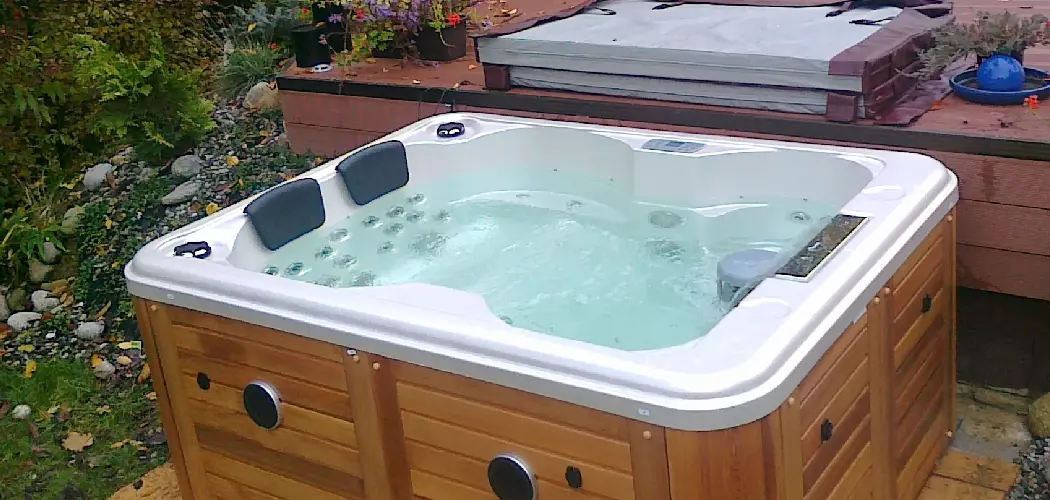Ensuring that your hot tub remains clean is not merely a matter of aesthetics; it is crucial for maintaining a hygienic and enjoyable soaking experience. Regular cleaning helps prevent the buildup of harmful bacteria and debris, which can compromise the water quality and potentially pose health risks for users. Additionally, a well-maintained hot tub enjoys a prolonged lifespan, saving you from costly repairs or replacement in the long run.
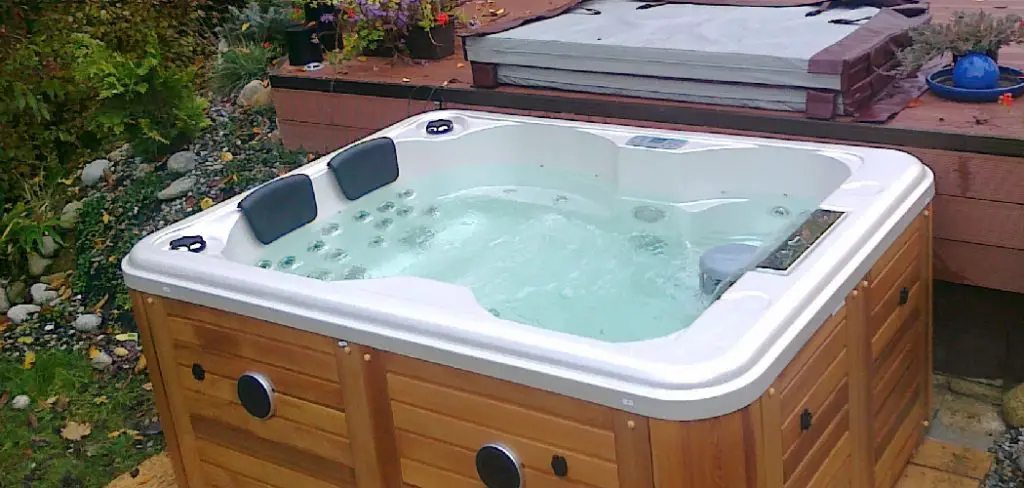
The purpose of this guide is to provide you with a comprehensive, step-by-step process on how to get dirt out of hot tub. Whether you are a seasoned hot tub owner or a first-time user, following these instructions will help keep your hot tub pristine. By the end of this guide, you will be well-equipped with the knowledge needed to maintain a clean and safe hot tub environment.
Understanding Hot Tub Filtration and Circulation
Hot Tub Filtration System:
The filtration system in a hot tub plays a critical role in maintaining clean and clear water. It passes water through a filter that traps dirt, debris, and other contaminants. There are three main types of filters used in hot tubs: cartridge filters, sand filters, and diatomaceous earth (DE) filters. Cartridge filters are the most common and consist of a pleated fabric that catches particles as water flows through.
Sand filters use a bed of sand to filter out impurities, while DE filters use a fine powder made from fossilized diatoms to capture even the smallest particles. Each type has its own advantages and maintenance requirements, but all serve the essential purpose of keeping your hot tub water clean.
Water Circulation:
Proper water circulation is just as important as filtration in maintaining a clean hot tub. Good circulation ensures that water is evenly distributed, which helps prevent stagnant areas where bacteria and algae can grow. Circulation pumps and jets work together to keep water moving continuously, pushing it through the filters and ensuring that chemicals are evenly distributed. This keeps the water clean and enhances the soaking experience by maintaining a consistent temperature and providing a gentle, soothing massage. Regularly checking and maintaining the circulation system is key to ensuring your hot tub’s overall water maintenance effectiveness.
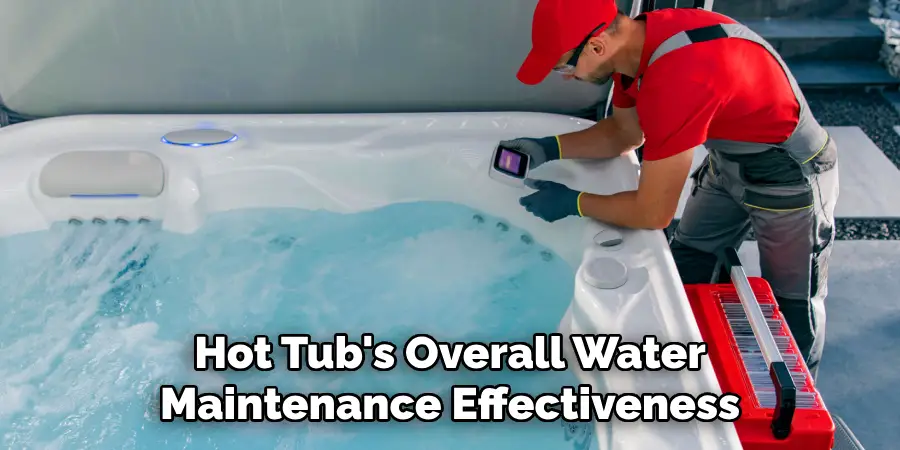
Tools and Materials Needed
Having the right tools and materials is essential to effectively clean and maintain your hot tub. Here is a list of basic cleaning tools, cleaning solutions, and maintenance supplies you’ll need:
Basic Cleaning Tools:
- Skimmer Net: For removing leaves, bugs, and other debris from the water’s surface.
- Soft Brush: Ideal for scrubbing the hot tub shell without scratching or damaging the surface.
- Vacuum: Useful for cleaning out dirt and debris from the bottom of the hot tub.
Cleaning Solutions:
- pH-Neutral Soap: Safe for the hot tub shell and effective in removing oils and dirt.
- Non-Abrasive Cleaners: Specifically designed to tackle stains and grime without scratching the hot tub surfaces.
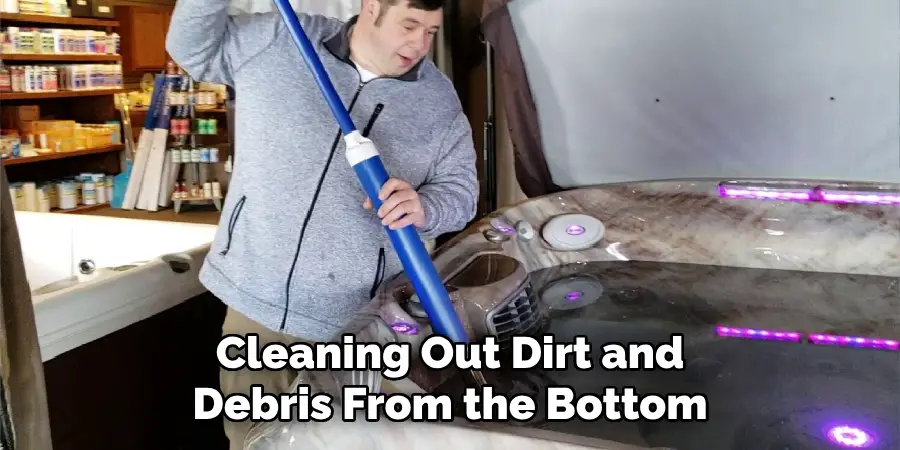
Maintenance Supplies:
- Replacement Filters: Essential for maintaining effective filtration and ensuring clean water.
- Test Strips for Water Chemistry: These help you regularly monitor the levels of pH, alkalinity, and sanitizer in your hot tub water.
- Chemicals (Chlorine, Bromine): Necessary for sanitizing the water and keeping it free from harmful bacteria and algae.
Preliminary Steps
Turn Off the Hot Tub:
Before you begin cleaning, you must ensure your safety by turning off the hot tub. This involves disconnecting the power supply to avoid electrical hazards while working. Turning off the hot tub also prevents the circulation system from running dry if you need to lower the water level for cleaning purposes. Always follow the manufacturer’s instructions when powering down your hot tub to ensure that it is done correctly and safely.
Remove Debris with a Skimmer Net:
Once the hot tub is turned off, the next step is to remove any visible debris from the water surface using a skimmer net. This tool captures leaves, bugs, and other floating dirt that can accumulate in your hot tub. Skimming should be done regularly to maintain a clean appearance and prevent debris from clogging the filtration system. Take your time to thoroughly skim the entire surface to ensure that you collect all floating debris.
Inspect and Remove Filters:
Filters are critical in keeping your hot tub water clean, so regular inspection and maintenance are essential. Begin by carefully removing the filters according to the manufacturer’s instructions. Once removed, inspect the filters for any signs of dirt, debris, or damage. If the filters appear dirty, they should be cleaned using a hose or a filter cleaning solution. For damaged or heavily clogged filters, replacement is necessary to maintain optimal filtration efficiency. Place clean or new filters back in their designated positions before proceeding with the next steps in the cleaning process.
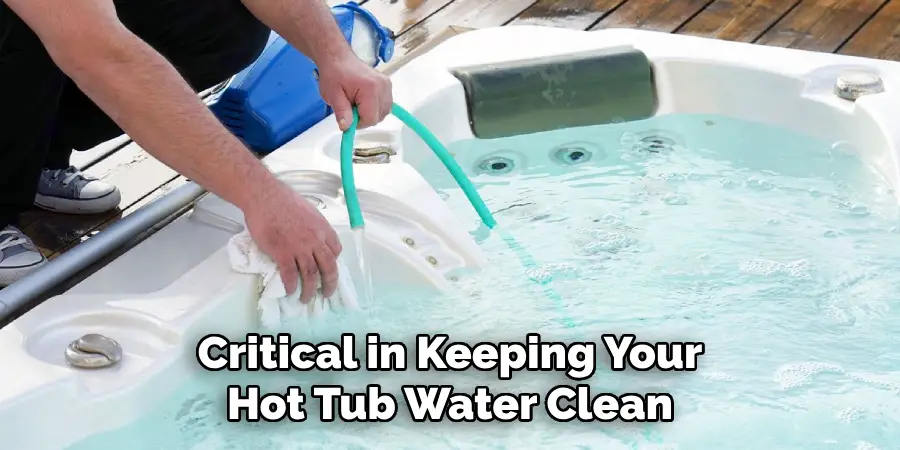
How to Get Dirt out Of Hot Tub: Draining the Hot Tub
When to Drain:
Draining your hot tub periodically is vital for maintaining a clean and healthy environment for users. Over time, chemical residues, body oils, and other contaminants build up in the water, even with regular maintenance. Periodic draining allows for a thorough, deep cleaning of the hot tub shell and plumbing system, preventing the build-up of biofilm and other deposits that can harbor bacteria. Experts recommend draining and refilling your hot tub every 3-4 months, depending on usage and water quality. High-usage hot tubs or those exposed to significant contaminants may require more frequent draining to ensure optimal cleanliness and water quality.
Steps to Drain the Hot Tub:
Locate and Open the Drain Valve:
Find the drain valve on your hot tub, which is usually located near the bottom of the tub. Refer to your owner’s manual if you have difficulty locating it. Once found, attach a garden hose to the valve to direct the water to a suitable drainage area, then open the valve to begin draining the water.
Using a Submersible Pump for Quicker Draining:
For a faster draining process, consider using a submersible pump. This type of pump can significantly reduce the time it takes to empty the hot tub, especially larger models. Place the submersible pump at the deepest part of the hot tub and connect the discharge hose to direct the water to your chosen drainage area. Turn on the pump and allow it to run until the hot tub is empty.
Proper Disposal of Water:
When disposing of the water from your hot tub, it is crucial to do so in an environmentally responsible manner. Ensure that the water is directed to a location that will not cause waterlogging or damage to plants, lawns, or local water systems. Avoid draining chemically treated water directly into storm drains or bodies of water, as this can harm aquatic life and ecosystems.
Instead, consider draining the water onto a permeable surface such as your lawn, where the soil can naturally filter and neutralize the chemicals. Always check local regulations and guidelines for water disposal to ensure compliance with environmental standards.
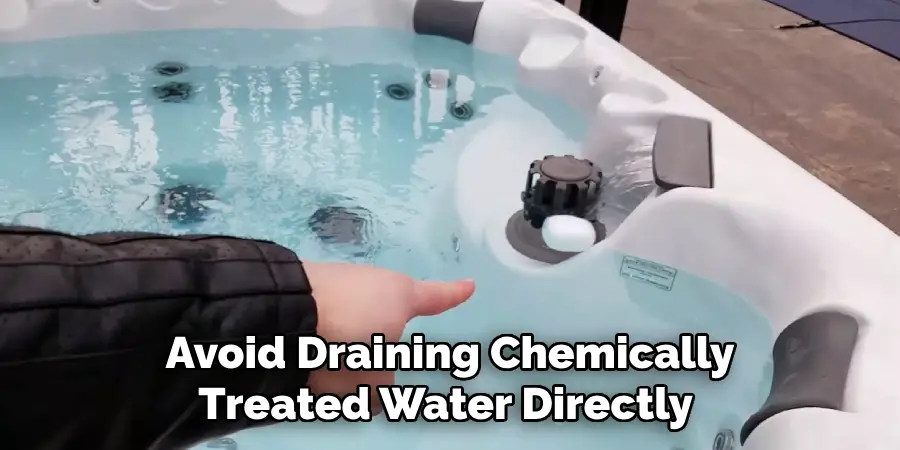
How to Get Dirt out Of Hot Tub: Cleaning the Hot Tub Shell
Scrubbing the Interior:
Using a Soft Brush and Non-Abrasive Cleaner:
The first step in cleaning the hot tub shell is to scrub the interior using a soft brush and a non-abrasive cleaner. These tools are vital as they effectively clean the surface without causing any damage to the hot tub’s material. Begin by applying the non-abrasive cleaner to the shell, following the product’s instructions for best results. Use the soft brush to gently scrub the shell, working in small sections to ensure thorough cleaning. Make sure you cover the entire surface, including the seats, footwell, and steps. Avoid using harsh chemicals or abrasive tools that could scratch or damage the finish of the hot tub.
Paying Special Attention to Corners and Crevices:
While scrubbing the interior, paying special attention to corners and crevices where dirt and grime tend to accumulate is crucial. These areas can be breeding grounds for bacteria and other contaminants if not properly cleaned. Use the soft brush to get into these hard-to-reach spots, ensuring that you remove all debris and buildup. An old toothbrush or a narrow cleaning brush can be particularly useful for scrubbing tight corners and intricate designs within the hot tub. Take the time to thoroughly clean these areas to maintain a hygienic and sparkling hot tub.
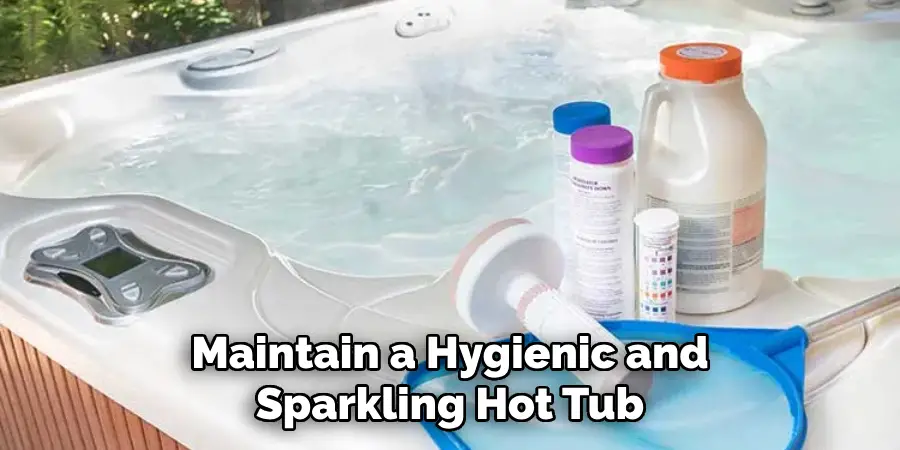
Removing Stains:
Identifying and Treating Common Stains:
During the cleaning process, you may encounter common stains such as oil, hard water, and algae stains. Each type of stain requires a specific approach for effective removal:
- Oil Stains: These stains are typically caused by body oils, lotions, and other personal care products. Use a specialized cleaner designed for oil removal and apply it to the affected areas. Allow the cleaner to sit briefly before scrubbing with a soft brush.
- Hard Water Stains: These are often the result of calcium and other mineral deposits left behind by hard water. Use a gentle descaling solution or a mixture of vinegar and water to dissolve the deposits. Apply the solution to the stains and scrub with a soft brush until the stains are gone.
- Algae Stains: Algae can occasionally thrive in the warm, moist environment of a hot tub. For algae stains, use an algaecide or a chlorine-based cleaner to kill the algae and remove the stains. Apply the cleaner to the stained areas and scrub thoroughly to eliminate all algae traces.
Rinsing the Shell:
Thoroughly Rinsing the Interior to Remove All Cleaning Residues:
Once the scrubbing and stain removal are completed, it’s essential to thoroughly rinse the interior of the hot tub to remove all cleaning residues. Leaving any residue behind can affect water chemistry and potentially irritate the skin of hot tub users. Use a garden hose to rinse the entire shell, making sure to reach all cleaned areas. Continue rinsing until the water runs clear and free of suds or debris. After rinsing, take a moment to inspect the shell for any missed spots or remaining residues and rinse again if necessary. Proper rinsing helps ensure that your hot tub is ready for the next step in the maintenance process, providing a clean and safe environment for relaxation and enjoyment.
Cleaning and Maintaining Filters
Deep Cleaning Filters:
Soaking Filters in a Cleaning Solution:
To ensure the filters in your hot tub remain effective, it’s important to periodically deep clean them. Start by removing the filters from the hot tub according to the manufacturer’s instructions. Prepare a bucket or large container filled with a filter cleaning solution, ensuring it is large enough to fully submerge the filters. Allow the filters to soak in the solution for the recommended amount of time, typically between 8 to 12 hours. This soaking process will help dissolve and dislodge dirt, oils, and other contaminants that have accumulated in the filter media over time.
Rinsing and Drying Before Reinserting:
After the soaking period, carefully remove the filters from the cleaning solution. Use a garden hose to thoroughly rinse the filters, ensuring all cleaning solution and debris have been removed. Pay special attention to the pleats, using a gentle stream of water to flush out any remaining particles. Once rinsed, allow the filters to air dry completely before reinserting them into the hot tub. This step is crucial to prevent moisture from fostering bacteria growth and to ensure the filters are in optimal condition for use.
Regular Maintenance:
How to Maintain Filters Between Deep Cleanings:
To maintain your filters between deep cleanings, it’s important to perform regular checks and light cleanings. Every 1 to 2 weeks, remove the filters and rinse them with a garden hose to remove surface debris. This routine helps to prolong the life of your filters and maintain the filtration efficiency of your hot tub. Additionally, periodically inspect the filters for signs of wear or damage, addressing minor issues promptly to prevent larger problems down the line.
When to Replace Filters:
Signs That a Filter Needs Replacing:
Even with regular maintenance and deep cleaning, filters will eventually need to be replaced. Common signs that a filter needs replacing include visible wear and tear, such as cracked or broken pleats, and a noticeable reduction in filtration efficiency. If you find that your water quality is deteriorating despite regular cleaning, or if the filter material feels stiff and inflexible, it may be time to invest in new filters. Generally, hot tub filters should be replaced every 12 to 24 months, but this can vary based on usage and water conditions. Always refer to the manufacturer’s guidelines for specific recommendations.
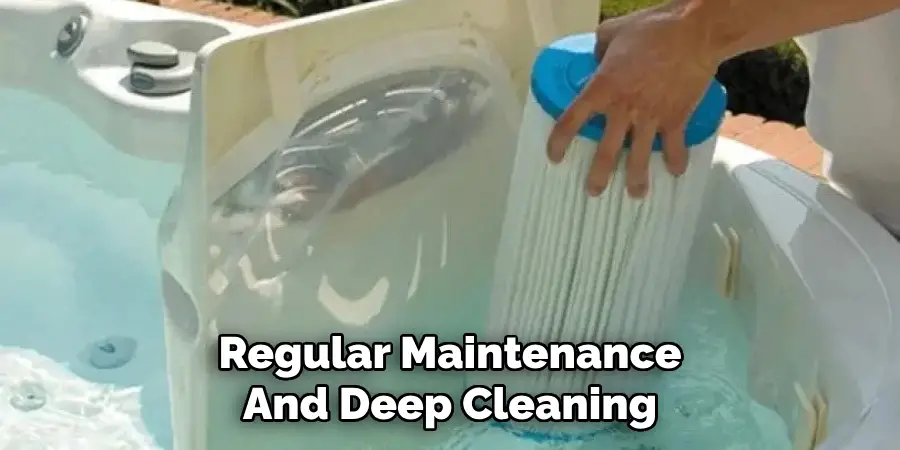
Refilling the Hot Tub
Proper Refilling Techniques:
Once cleaning and filter maintenance are complete, the next step is to refill the hot tub. To avoid air locks and ensure an even filling process, follow these steps: First, insert a garden hose equipped with a pre-filter into the filter compartment or directly into the main body of the hot tub. This helps to minimize the introduction of contaminants from the tap water.
Turn on the hose and begin filling the tub, ensuring the water level rises slowly and evenly. Avoid filling the tub too quickly, as this can create air pockets in the plumbing, potentially leading to air locks which can hinder the circulation system’s efficiency. Periodically check for any leaks or unusual noises that might indicate air traps in the system.
Balancing Water Chemistry:
After refilling, it’s crucial to balance the water chemistry to maintain a healthy and safe hot tub environment. Start by testing the water using test strips or a digital tester to measure pH, alkalinity, and sanitizer levels. The ideal pH level should be between 7.2 and 7.6, while the optimal total alkalinity range is 80 to 120 ppm. Adjust the pH and alkalinity using appropriate chemicals as needed. Next, ensure the sanitizer level (such as chlorine or bromine) is within the recommended range to effectively kill bacteria and other contaminants. Properly balanced water not only extends the lifespan of your hot tub but also ensures a comfortable and safe soaking experience for users.
Circulating Water:
To evenly distribute the chemicals throughout the hot tub, run the circulation pump for at least 30 minutes after adding any balancing agents. This helps to ensure that the water is uniformly treated and free from any chemical hotspots. Turn on all jets and air features to promote thorough mixing. Regular circulation keeps the water clean and balanced, reducing the need for frequent chemical adjustments and enhancing overall water quality.
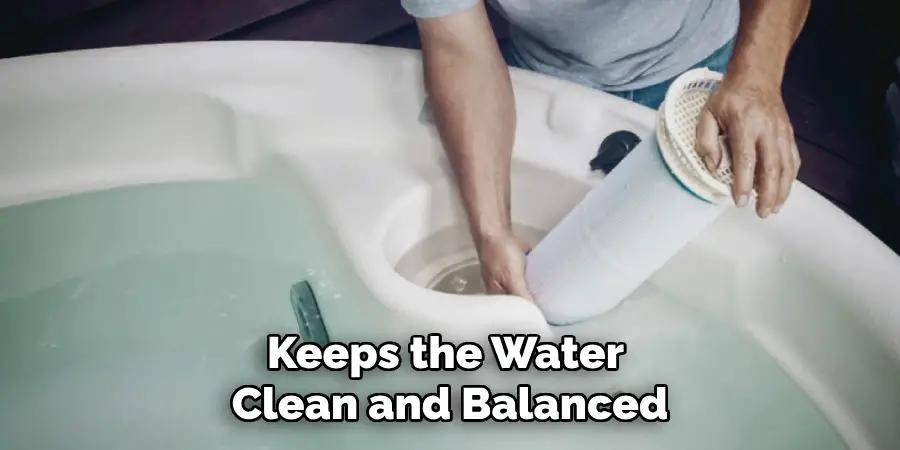
Conclusion
Proper maintenance is key to ensuring the cleanliness and longevity of your hot tub. Essential steps include regularly testing and adjusting water chemistry, using a cover to prevent debris, encouraging good hygiene practices, and conducting routine inspections for leaks and equipment efficiency. Addressing common issues like cloudy water, persistent stains, and unpleasant odors promptly will help maintain a pleasant soaking experience.
Regular maintenance is not just about preserving your investment; it’s essential for your health and enjoyment. A clean hot tub means fewer contaminants and a safer, more relaxing environment for everyone.
Consistency is crucial in maintaining a pristine hot tub. Establish a regular cleaning routine, and be proactive with inspections and chemical adjustments. Remember, knowing how to get dirt out of hot tub systems effectively will keep your spa clean and inviting. With these practices, you’ll ensure your hot tub remains a source of relaxation and enjoyment for years to come.

